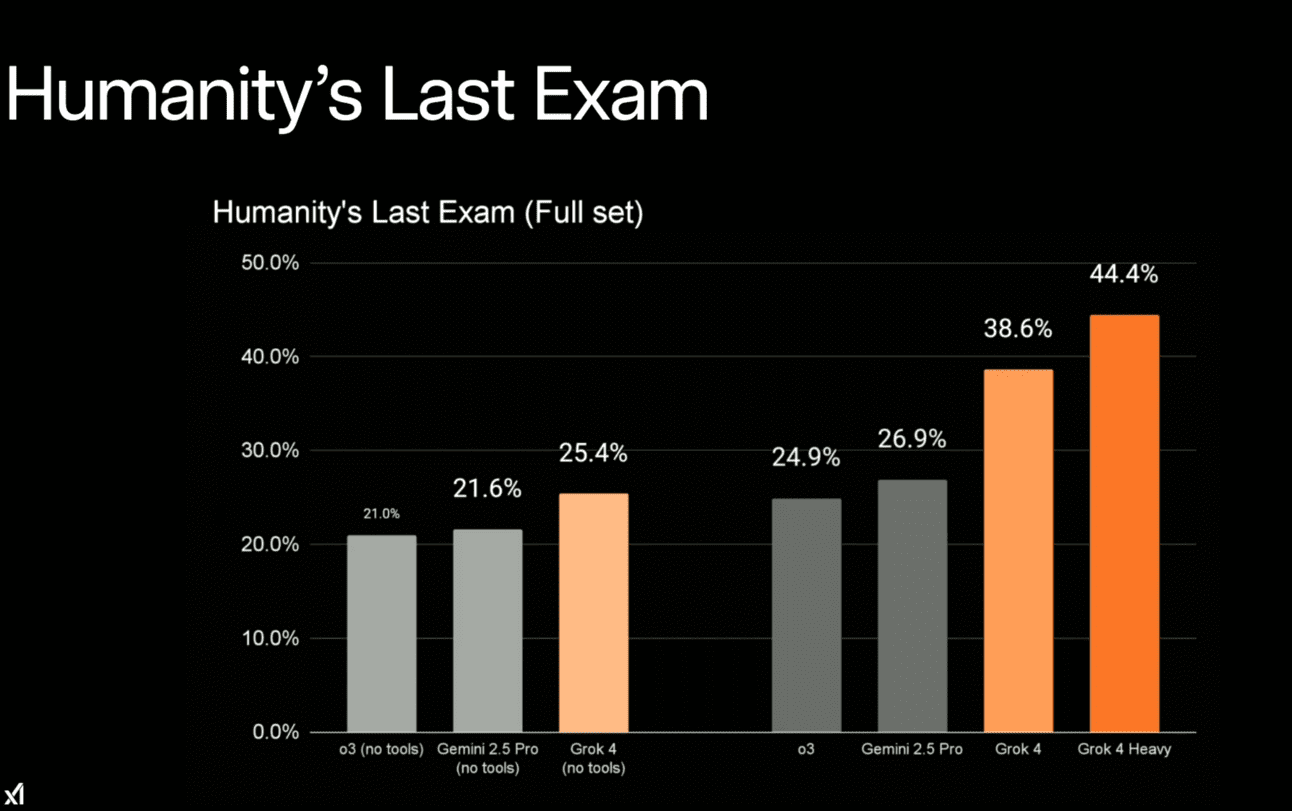Hello Engineering Leaders and AI Enthusiasts!
This newsletter brings you the latest AI updates in a crisp manner! Dive in for a quick recap of everything important that happened around AI in the past two weeks.
And a huge shoutout to our amazing readers. We appreciate you😊
In today’s edition:
🧠 Meta poaches Apple’s AI model chief
🤖 xAI returns with Grok 4 and 4 Heavy
🚀 Apple eyes OpenAI and Anthropic for Siri revamp
🎙️ Baidu open-sources ERNIE 4.5 to rival DeepSeek
🧑Google expands MedGemma for health AI
🧪 Prisoner’s Dilemma reveals AI personalities
🩺 Microsoft’s AI beats doctors in tests
💡 Knowledge Nugget: The AI Bubble Is Real. So Is the AI Revolution by OMC
Let’s go!
Meta poaches Apple’s AI model chief
Meta just hired Ruoming Pang, the executive who led Apple’s foundation model team, offering a reported compensation package exceeding $200 million. Pang was responsible for shaping the models powering Apple Intelligence and next-gen Siri. He now joins Meta’s Superintelligence division, led by Alexandr Wang, alongside other recent hires from OpenAI and Anthropic.
Meta is said to have poached over 10 OpenAI researchers, with signing bonuses reportedly reaching $100 million, as CEO Mark Zuckerberg doubles down on building AI systems that rival or outperform humans.
Why does this matter?
The AI talent war has gone nuclear, and Meta’s emerging as the early leader. With top minds and deep pockets, it’s building frontier AI systems faster than rivals can hold onto their best people.
xAI returns with Grok 4 and 4 Heavy
xAI has launched Grok 4 and its more powerful counterpart, Grok 4 Heavy, positioning both as top-tier reasoning AIs with voice, vision, and huge context windows (128K and 256K, respectively). The models achieve state-of-the-art results across key tests like Humanity’s Last Exam and Arc-AGI-2, outperforming OpenAI’s o3 and Gemini 2.5 Pro.
Grok 4 is included in the $30/month SuperGrok plan, while Grok 4 Heavy is part of a new $300/month “Heavy” tier aimed at more advanced use cases. The API version offers built-in search and aggressive pricing, with a 256K context window and multi-agent orchestration for complex tasks.
Why does it matter?
xAI isn’t playing catch-up anymore. Grok 4’s leap puts it in the same arena as OpenAI and Google, while its pricing and multi-agent setup hint at a serious enterprise push. But with Grok 3’s past still fresh, every upgrade now comes with extra eyes watching.
Apple eyes OpenAI and Anthropic for Siri revamp
Apple is reportedly in talks to integrate external AI models from Anthropic or OpenAI into Siri, after internal efforts to build its own Foundation Models fell short. The company has asked both vendors to train custom models optimized for Apple’s cloud infrastructure, powered by Mac chips, aiming to improve Siri’s capabilities without compromising privacy.
While Anthropic’s Claude has reportedly performed well in Apple’s tests, talks have stalled over pricing. Anthropic is seeking annual fees in the tens of billions, prompting Apple to explore other options, including OpenAI. Senior leaders inside Apple are said to favor this shift, seeing external partnerships as the fastest way to upgrade Siri before its 2026 overhaul deadline.
Why does it matter?
Apple betting on rivals’ models for Siri shows just how far behind it is. With its in-house AI still falling short, tapping OpenAI or Anthropic is less a choice and more a scramble to stay competitive in the next phase of the AI race.
Baidu open-sources ERNIE 4.5 to rival DeepSeek
Baidu just open-sourced 10 versions of its new ERNIE 4.5 model family, including a 424B parameter multimodal system that beats DeepSeek V3 in 22 out of 28 benchmarks. The lineup ranges from 300M to 424B models, all released under Apache 2.0 on Hugging Face. It’s Baidu’s first major step into open-source LLMs.
ERNIE 4.5 uses a “heterogeneous” training setup, letting text and vision modules reinforce rather than compete, boosting efficiency. The larger models also hold their own against frontier systems like GPT-4.1, o1, and Qwen 3 across tasks.
Why does it matter?
While U.S. labs battle for frontier dominance, China’s AI giants are accelerating their own race. Baidu’s ERNIE 4.5 adds more pressure to DeepSeek, Qwen, and others competing for the top of the open-source AI stack.
Google expands MedGemma for health AI
Google has released two powerful new additions to its open-source MedGemma family, including a 27B multimodal model designed to interpret X-rays, skin conditions, and patient records. The models outperform similarly sized systems on medical benchmarks and are already being used to generate real diagnostic reports.
With up to 87.7% accuracy on MedQA and 81% success in real X-ray reporting tests, MedGemma is showing promise not just as a research tool but as a practical assistant in hospitals. The smaller variant runs on local hardware, opening doors for lower-cost or remote applications across different care settings.
Why does it matter?
MedGemma puts high-quality diagnostic capabilities in reach for anyone with a laptop or phone. By open-sourcing these models, Google is making it easier for clinics, researchers, and startups worldwide to build better healthcare tools without massive compute budgets.
Prisoner’s Dilemma reveals AI personalities
A new study tested OpenAI, Google, and Anthropic models in 140,000 rounds of the Prisoner’s Dilemma (a game theory experiment where two players choose to either cooperate or betray each other) to see how well they could reason strategically. Each AI had to choose whether to cooperate or defect, generating a written explanation for each decision based on observed opponent behavior and game context.
The result? Distinct styles emerged. Gemini was highly adaptive and quick to retaliate. OpenAI models leaned toward cooperation, even when it meant getting exploited. Claude turned out to be the most forgiving, often re-extending trust. Researchers described these behaviors as “strategic fingerprints,” hinting that different labs are tuning for very different AI personalities.
Why does it matter?
The fact that models trained on similar data develop contrasting strategies suggests there’s more going on than next-token prediction. As LLMs take on decisions in areas like policy, trading, or ops, these behavioral quirks could become high-stakes variables.
Microsoft’s AI beats doctors in tests
Microsoft has introduced the MAI Diagnostic Orchestrator (MAI-DxO)- an AI system that simulates a virtual team of medical experts and achieves 4x higher diagnostic accuracy than seasoned physicians in complex cases. It works by coordinating specialized AI agents to generate hypotheses, choose tests, and monitor costs across patient scenarios.
Tested on 304 challenging cases in a new benchmark (SDBench), the MAI-DxO + OpenAI o3 combo solved 85.5% of them correctly, compared to just 20% by doctors with 5–20 years of experience. The AI system also proved more cost-efficient, saving over $500 per case on average.
Why does it matter?
MAI’s diagnostic accuracy tackles a real flaw in healthcare: too many tests for simple problems and missed calls on complex ones. Matching expert-level reasoning while reducing costs gives AI a real shot at improving medical decision-making, not just automating it.
Enjoying the latest AI updates?
Refer your pals to subscribe to our newsletter and get exclusive access to 400+ game-changing AI tools.
When you use the referral link above or the “Share” button on any post, you’ll get the credit for any new subscribers. All you need to do is send the link via text or email or share it on social media with friends.
Knowledge Nugget: The AI Bubble Is Real. So Is the AI Revolution
In this article, OMC reflects on the strange duality of the current AI boom: it’s both a genuine breakthrough and a textbook bubble. Like the dot-com era, we’re watching history rhyme, VCs pouring capital into thin wrappers over foundation models, startups promising AGI next year, and inflated valuations based on hype, not moats. But unlike crypto manias or Pets.com, AI is already delivering real utility, making the bubble harder to spot and potentially riskier when it bursts.
The article outlines why post-bubble winners will be the ones solving boring, high-value problems with technical depth, not chasing AGI headlines. Builders should ignore the noise and solve specific problems. Investors should seek founders for whom AI is a means, not a pitch deck buzzword. The hype will fade, but the infrastructure will remain.
Why does it matter?
Being early is often the same as being wrong. This is a reminder that long-term value in AI won’t be built on hype cycles; it’ll come from solving real problems, patiently and quietly, while others are chasing AGI headlines.
What Else Is Happening❗
🧪 OpenAI-backed Chai Discovery announced Chai-2, an AI that designs antibody drugs from scratch with a 20% success rate,100x higher than traditional methods.
🛡️ Cloudflare will now block AI crawlers by default on new sites and has launched a “Pay per Crawl” marketplace letting publishers charge bots for access.
🧠 Sakana AI releases TreeQuest, a framework for combining ChatGPT, Gemini, and DeepSeek to solve tasks through collaborative model reasoning.
🧬 Alphabet’s Isomorphic Labs will soon begin human trials for its AI-designed cancer drugs, aiming to build a “drug design engine” to tackle all diseases eventually.
📉 A new survey from Resume Builder finds 60% of managers now use AI to make key decisions on raises, promotions, and firings often without formal training or oversight.
🎓 AFT teams up with OpenAI, Microsoft, and Anthropic to launch a national AI academy aimed at training 400,000 U.S. educators to bring AI into classrooms.
🎬 Moonvalley unveils Marey, an AI video model trained on licensed content, giving filmmakers precise scene control while avoiding copyright risks.
🧭 Perplexity debuts Comet, an AI browser with an embedded assistant that automates tasks like booking meetings and navigating websites via natural language.
New to the newsletter?
The AI Edge keeps engineering leaders & AI enthusiasts like you on the cutting edge of AI. From machine learning to ChatGPT to generative AI and large language models, we break down the latest AI developments and how you can apply them in your work.
Thanks for reading, and see you next week! 😊
Read More in The AI Edge






